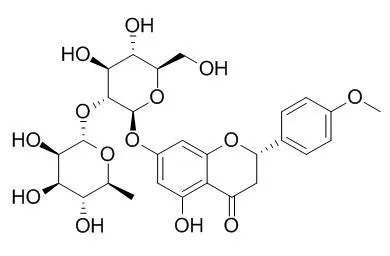| Description: |
Poncirin has anticancer, anti-bacterial and anti-inflammatory activities; it prevents adipogenesis, enhances osteoblast differentiation in mesenchymal stem cellsincreased bone mineral density, and improves trabecular microarchitecture likely reflect increases bone formation and decreases bone resorption in GIO mice. Poncirin inhibits iNOS, COX-2, TNF-alpha and IL-6 expression via the down-regulation of NF-kappaB binding activity.
|
| In vitro: |
| Int J Mol Sci. 2013 Apr 24;14(5):8684-97. | | Characterization, Purification of Poncirin from Edible Citrus Ougan (Citrus reticulate cv. Suavissima) and Its Growth Inhibitory Effect on Human Gastric Cancer Cells SGC-7901.[Pubmed: 23615464] | Poncirin is a bitter flavanone glycoside with various biological activities. Poncirin was isolated from four different tissues (flavedo, albedo, segment membrane, and juice sac) of Ougan fruit (Citrus reticulate cv. Suavissima).
METHODS AND RESULTS:
The highest content of Poncirin was found in the albedo of Ougan fruit (1.37 mg/g DW). High speed counter-current chromatography (HSCCC) combined with D101 resin chromatography was utilized for the separation and purification of Poncirin from the albedo of Ougan fruit. After this two-step purification, Poncirin purity increased from 0.14% to 96.56%. The chemical structure of the purified Poncirin was identified by both HPLC-PDA and LC-MS. Poncirin showed a significant in vitro inhibitory effect on the growth of the human gastric cancer cells, SGC-7901, in a dose-dependent manner.
CONCLUSIONS:
Thus, Poncirin from Ougan fruit, may be beneficial for gastric cancer prevention. The purification method demonstrated here will be useful for further studies on the pharmacological mechanism of Poncirin activity, as well as for guiding the consumption of Ougan fruit. | | J Microbiol Biotechnol. 2015 Jan 28;25(1):18-25. | | Metabolism of rutin and poncirin by human intestinal microbiota and cloning of their metabolizing α-L-rhamnosidase from Bifidobacterium dentium.[Pubmed: 25179902] |
METHODS AND RESULTS:
To understand the metabolism of flavonoid rhamnoglycosides by human intestinal microbiota, we measured the metabolic activity of rutin and Poncirin (distributed in many functional foods and herbal medicine) by 100 human stool specimens. The average α-Lrhamnosidase activities on the p-nitrophenyl-α-L-rhamnopyranoside, rutin, and Poncirin subtrates were 0.10 ± 0.07, 0.25 ± 0.08, and 0.15 ± 0.09 pmol/min/mg, respectively. To investigate the enzymatic properties, α-L-rhamnosidase-producing bacteria were isolated from the specimens, and the α-L-rhamnosidase gene was cloned from a selected organism, Bifidobacterium dentium, and expressed in E. coli. The cloned α-L-rhamnosidase gene contained a 2,673 bp sequcence encoding 890 amino acid residues. The cloned gene was expressed using the pET 26b(+) vector in E. coli BL21, and the expressed enzyme was purified using Ni(2+)-NTA and Q-HP column chromatography. The specific activity of the purified α-L-rhamnosidase was 23.3 μmol/min/mg. Of the tested natural product constituents, the cloned α-L-rhamnosidase hydrolyzed rutin most potently, followed by Poncirin, naringin, and ginsenoside Re. However, it was unable to hydrolyze quercitrin.
CONCLUSIONS:
This is the first report describing the cloning, expression, and characterization of α-L-rhamnosidase, a flavonoid rhamnoglycosidemetabolizing enzyme, from bifidobacteria. Based on these findings, the α-L-rhamnosidase of intestinal bacteria such as B. dentium seem to be more effective in hydrolyzing (1-->6) bonds than (1-->2) bonds of rhamnoglycosides, and may play an important role in the metabolism and pharmacological effect of rhamnoglycosides. | | Biol Pharm Bull. 1999 Apr;22(4):422-4. | | Anti-Helicobacter pylori activity of the metabolites of poncirin from Poncirus trifoliata by human intestinal bacteria.[Pubmed: 10328566] | Poncirin was isolated from water extract of the fruits of Poncirus trifoliata and metabolized by human intestinal bacteria.
METHODS AND RESULTS:
The inhibitory effect of Poncirin and its metabolites by these bacteria on the growth of Helicobacter pylori (HP) was investigated. Among them, ponciretin (5,7-dihydroxy-4'-methoxyflavanone), the main metabolite most potently inhibited the growth of HP, with a minimum inhibitory concentration (MIC) of 10-20 microg/ml.
CONCLUSIONS:
However, Poncirin and its metabolites except ponciretin did not inhibit the growth of HP, nor did they inhibit HP urease. |
|
| In vivo: |
| J Bone Miner Metab. 2012 Sep;30(5):509-16. | | Poncirin prevents bone loss in glucocorticoid-induced osteoporosis in vivo and in vitro.[Pubmed: 22407507] | Poncirin, a flavonoid isolated from the fruit of Poncirus trifoliata, possesses anti-bacterial and anti-inflammatory activities. However, the action of Poncirin in bone biology is unclear. In this study, the in vivo and in vitro effects of Poncirin in a glucocorticoid-induced osteoporosis (GIO) mouse model were investigated.
METHODS AND RESULTS:
Seven-month-old male mice were assigned to the following five groups: (1) sham-implantation (sham), (2) prednisolone 2.1 mg/kg/day (GC), (3) GC treated with 10 mg/kg/day of genistein, (4) GC treated with 3 mg/kg/day of Poncirin, (5) and GC treated with 10 mg/kg/day of strontium (GC + SrCl(2)). After 8 weeks, bone loss was measured by microcomputed tomography. Osteocalcin (OC) and C-terminal telopeptides of type I collagen (CTX) were evaluated in sera. Runx2 protein, OC and osteoprotegerin (OPG) mRNA expression, alkaline phosphatase (ALP) activity, and mineral nodule assay were performed in C3H10T1/2 or primary bone marrow stromal cells. Poncirin significantly increased the bone mineral density and improved the microarchitecture. Poncirin increased serum OC, Runx2 protein production, expression of OC and OPG mRNA, ALP activity, and mineral nodule formation; and decreased serum CTX. These effects were more prominent in the Poncirin group compared to the other positive control groups (genistein and strontium).
CONCLUSIONS:
The Poncirin-mediated restoration of biochemical bone markers, increased bone mineral density, and improved trabecular microarchitecture likely reflect increased bone formation and decreased bone resorption in GIO mice. |
|






 Cell. 2018 Jan 11;172(1-2):249-261.e12. doi: 10.1016/j.cell.2017.12.019.IF=36.216(2019)
Cell. 2018 Jan 11;172(1-2):249-261.e12. doi: 10.1016/j.cell.2017.12.019.IF=36.216(2019) Cell Metab. 2020 Mar 3;31(3):534-548.e5. doi: 10.1016/j.cmet.2020.01.002.IF=22.415(2019)
Cell Metab. 2020 Mar 3;31(3):534-548.e5. doi: 10.1016/j.cmet.2020.01.002.IF=22.415(2019) Mol Cell. 2017 Nov 16;68(4):673-685.e6. doi: 10.1016/j.molcel.2017.10.022.IF=14.548(2019)
Mol Cell. 2017 Nov 16;68(4):673-685.e6. doi: 10.1016/j.molcel.2017.10.022.IF=14.548(2019)